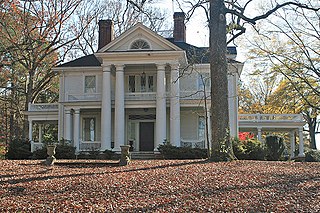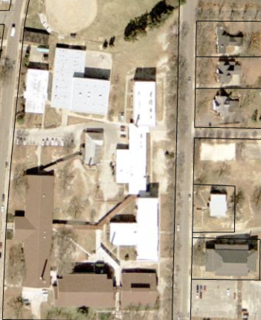
Fuquay-Varina is a town in southern Wake County, North Carolina, United States, lying south of Holly Springs and southwest of Garner, and north of the Harnett County town of Angier and west of the unincorporated community of Willow Springs. The population was 17,937 at the 2010 census, and estimated at 30,324 as of July 2019. The hyphenated name attests to the town's history as two separate towns. Fuquay Springs and Varina merged in 1963 to create the modern town. Economically, the town initially grew due to tobacco trade and agriculture, but has seen recent population growth and real estate development due to its proximity to Research Triangle Park.

The Davis–Adcock Store is a historic general store located at Wilbon, North Carolina, a crossroads north of Fuquay-Varina, in Wake County, North Carolina. The building was constructed in 1906, and is a one-story, frame, gable-front building, with a standing-seam metal roof and a stepped-parapet false front. The community store served not only as a local distribution center for goods and services, but also as a center of community social life. The building also housed the local post office from 1906 until 1925.

The Apex Historic District is the historic commercial and residential center of Apex, North Carolina, a satellite town of the state capital Raleigh. The district revolves around Salem Street, the main thoroughfare in downtown Apex. In 2007, CNNMoney.com ranked Apex as the 14th best place to live in the United States. The report cited the Historic District as one reason for the award and described the district as "quaint, impressively intact, and with an array of commercial and residential buildings now serving visitors and residents alike." On March 17, 1994, the Apex Historic District was listed on the National Register of Historic Places. The district boundaries were expanded in 1995, 2002, and 2008, and include Hunter, Center, Chatham, Cunningham, Holleman, and Hughes Streets.

Fuquay-Varina High School (FVHS) is a public high school in Fuquay-Varina, North Carolina. The current principal is Terrance McCotter, who took that position in 2019. Mr. McCotter is both an alumnus and former math teacher at the school. FVHS was named a "School of Distinction" in 2003, 2004, and 2005.

Franklinton Depot, also known as the Raleigh and Gaston Railroad Passenger Depot and Franklinton Woman's Club Clubhouse, is a historic train station located at 201 East Mason Street in Franklinton, Franklin County, North Carolina. It was built by the Raleigh and Gaston Railroad in 1886, and is a one-story, rectangular frame building with Italianate, Queen Anne, and Gothic Revival style design elements. The main section measures 51 feet by 16 feet, with an attached 10 feet by 12 feet baggage room. The main section has a steeply pitched gable roof and baggage room a low-pitched hip roof. It was moved to its present location in 1973 when acquired by the Franklinton Woman's Club as a clubhouse.

J. Beale Johnson House is a historic home located near Fuquay-Varina, Wake County, North Carolina. The house was built about 1906, and is a two-story, double pile, Classical Revival style frame dwelling. It is sheathed in weatherboard, sits on a brick foundation, hipped roof, and rear ell. It features a two-story pedimented front portico supported by Doric order columns and one-story wraparound porch with porte cochere.

Kemp B. Johnson House is a historic home located near Fuquay-Varina, Wake County, North Carolina. The house was built about 1896, and is a 1 1/2-story, double pile, Queen Anne style frame dwelling. It has a high hipped roof and full-width front porch with intricate sawnwork decoration. A one-story, side-gable, three-bay wing was added about 1905.

Fuquay Springs High School, also known as Fuquay-Varina Middle School, is a historic high school located at Fuquay-Varina, Wake County, North Carolina. It was built about 1925, and is a two-story, rectangular, flat-roofed, red brick, Colonial Revival style building. It has a one-story rear auditorium wing. The school was connected by an open breezeway to a cafeteria building built about 1948. In the early 2000s the campus underwent a renovation and addition by the Wake County Public School System which consisted in converting the existing 1925 building into an administration hall along with a few classrooms. The 1948 construction was demolished along with a few other buildings. The renovation took place to address the issue of students having to go outside to switch classes, so the buildings on the north end of the campus with the exception of the gym was demolished. The new construction ties the rest of the buildings from the north end of the campus to the south end opening in 2003.

Fuquay Springs Teacherage is a historic teacherage located at Fuquay-Varina, Wake County, North Carolina. It was built about 1925, as a Bungalow / American Craftsman style residence. It was more than doubled in size in 1947, when the Wake County Board of Education purchased the property for use as a teacherage. It is a two-story, red brick building with a low hipped roof and wide eaves. It features a full width, hip roofed front porch on the original section.

Ben-Wiley Hotel is a historic hotel building located at Fuquay-Varina, Wake County, North Carolina. It was built in 1925, and is a Bungalow / American Craftsman style frame building consisting of two hip-roofed blocks; the two-story main block with a hip roofed front porch, and a two-story rear block. It is sheathed in weatherboard and has widely overhanging eaves. It was converted from 12 hotel rooms to 6 apartments in 1947.

Fuquay Mineral Spring is a historic mineral spring located at Fuquay-Varina, Wake County, North Carolina. The spring was discovered in the 1850s, and, from 1900 to 1930, thousands of people visited the spring to drink the mineral water reputed to cure kidney and intestinal ailments. The spring is covered by a gazebo and reached by a small footbridge.

Fuquay Springs Historic District is a national historic district located at Fuquay-Varina, Wake County, North Carolina. The districts encompasses 36 contributing buildings and 1 contributing site in the town of Fuquay-Varina. The predominantly residential district developed between about 1899 and 1946, and includes notable examples of Queen Anne, Colonial Revival, Tudor Revival, and Bungalow / American Craftsman architecture. Located in the district are the separately listed Ben-Wiley Hotel and Fuquay Mineral Spring. Other notable buildings include the Varina Mercantile Building (1899), Barham Hotel, Ballentine-Spence House, Barbour-Perkins House, Proctor House (1925), and Harold Johnson House (1938).

Jones–Johnson–Ballentine Historic District is a national historic district located near Fuquay-Varina, Wake County, North Carolina. The district encompasses 18 contributing buildings, 3 contributing sites, and 8 contributing structures on the Johnson Farm and the Ballentine Farm near Fuquay-Varina. The district includes notable examples of Classical Revival and Victorian style architecture. Notable resources include the William Wesley Johnson House, The Log Cabin, James E. Ballentine House (1890), The Creamery, Dairy Barn (1915), a family cemetery and the surrounding farm landscape.

Varina Commercial Historic District is a national historic district located at Fuquay-Varina, Wake County, North Carolina. The district encompasses 12 contributing buildings in the central business district of Fuquay-Varina. The district developed between about 1899 and 1926, and includes notable examples of early-20th century commercial architecture. Notable buildings include the Union Station, Varina Hotel, Bank of Varina, Varina Garage and Machine Company Building, Drug Store, and Bank of Varina (1926).

Wayland H. and Mamie Burt Stevens House is a historic home located at Fuquay-Varina, Wake County, North Carolina. The house was built in 1936, and is a two-story, Colonial Revival style brick dwelling with a hipped roof. It features an entry portico and a front door with fanlight and sidelights. Also on the property are the contributing garage (1936) and tool shed (1936).

The Carrizozo Woman's Club, at 908 Eleventh St., Carrizozo, New Mexico is a woman's club. Its building was constructed in 1939 and was listed on the National Register of Historic Places in 2003.

The Woman's Club of Topeka was named as an entity in 1916 but has earlier roots. Its building, located just one-half block west of the Kansas State Capitol and completed in 1925, was listed on the National Register of Historic Places in 1982.

The Woman's Club of Lincoln is a historic women's club. Its clubhouse, at 499 E St. in Lincoln, California, was listed on the National Register of Historic Places in 2001.
A teacherage is a house for one or more schoolteachers, like a parsonage is a house for a parson or minister of a Protestant church.



















